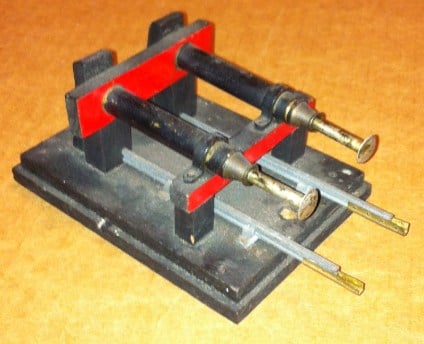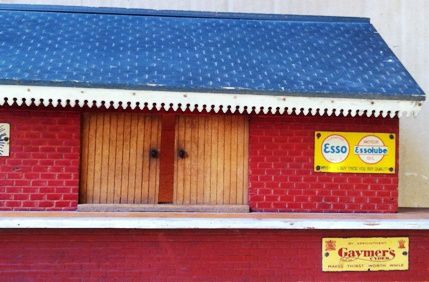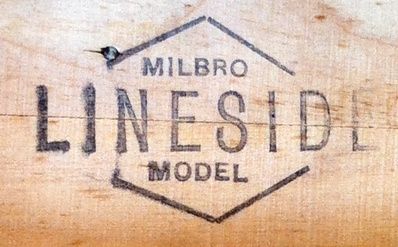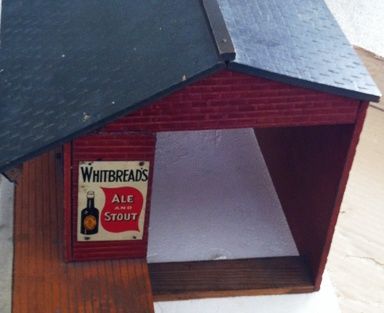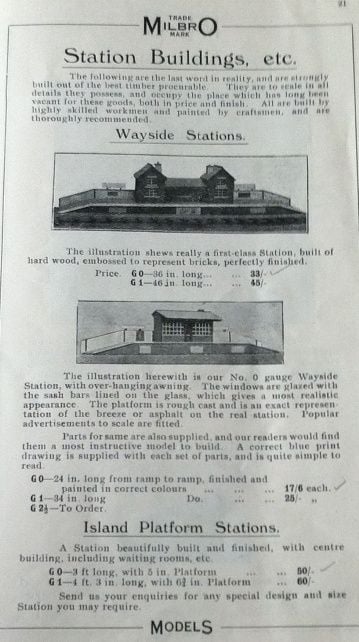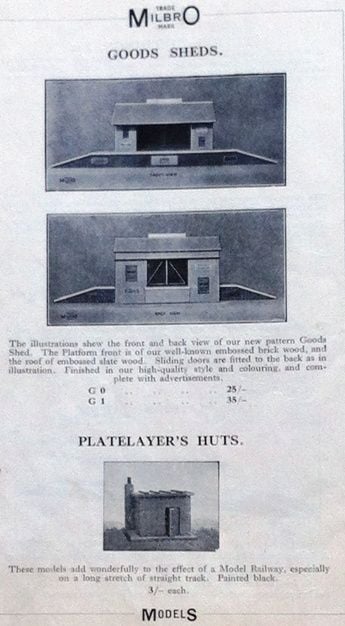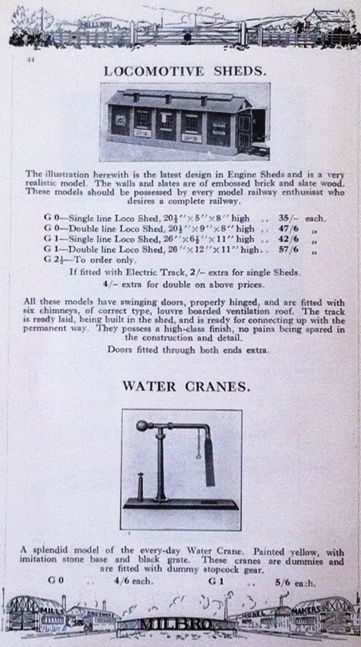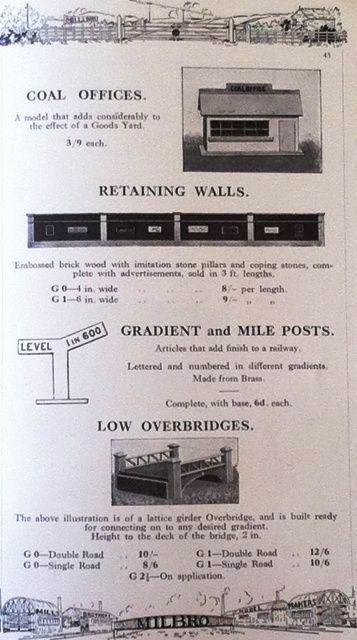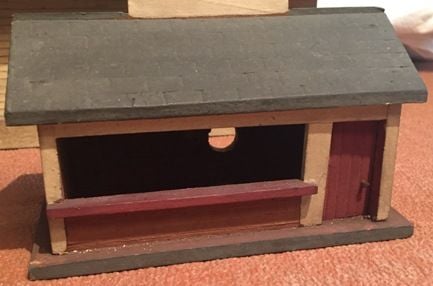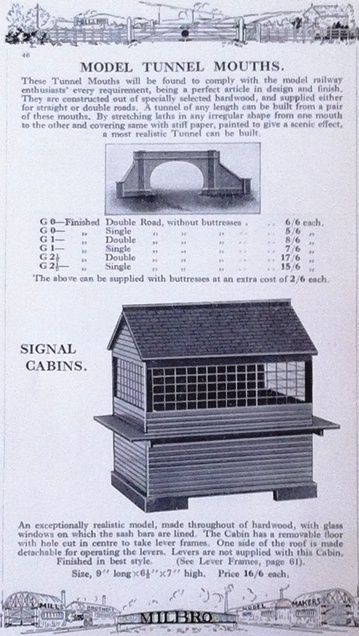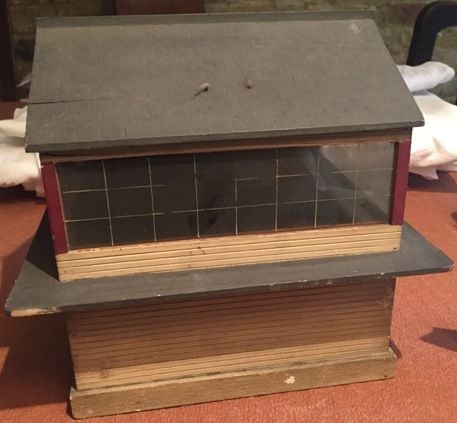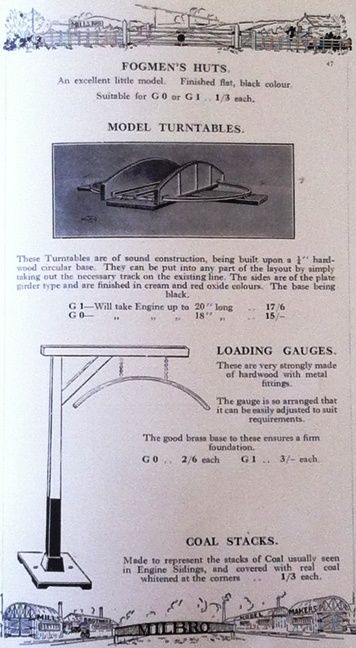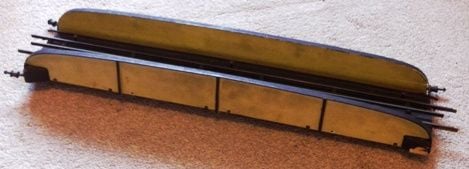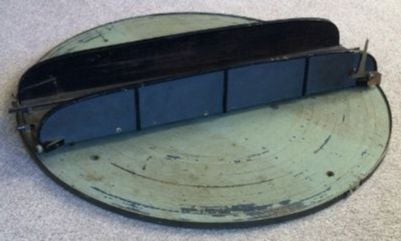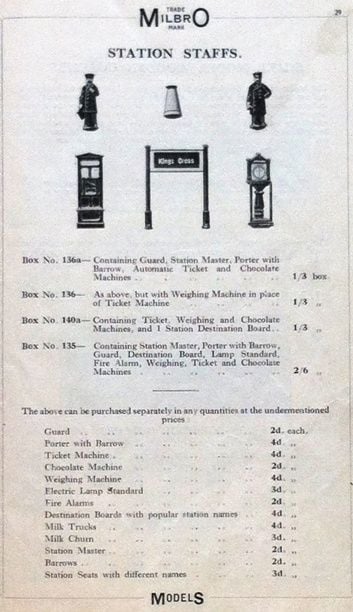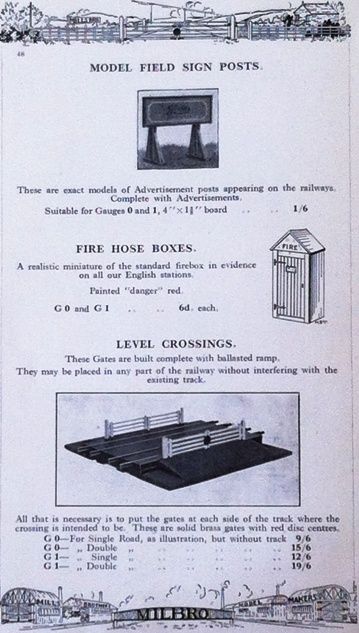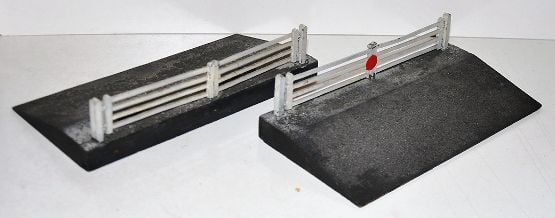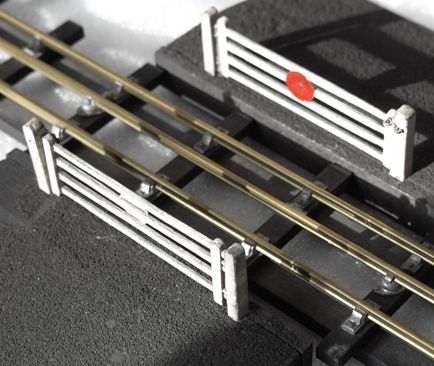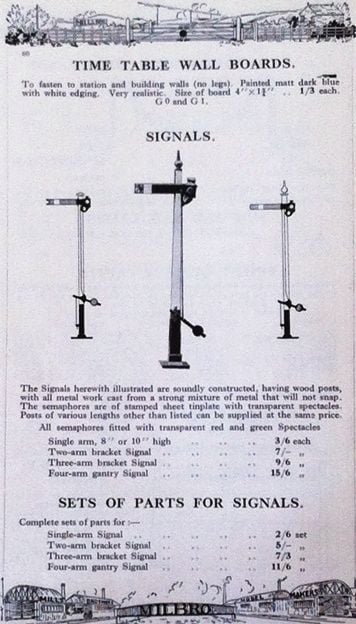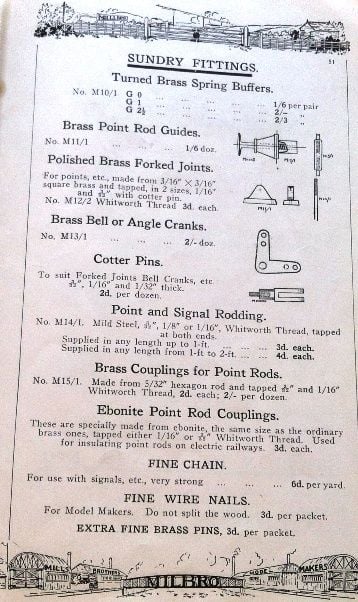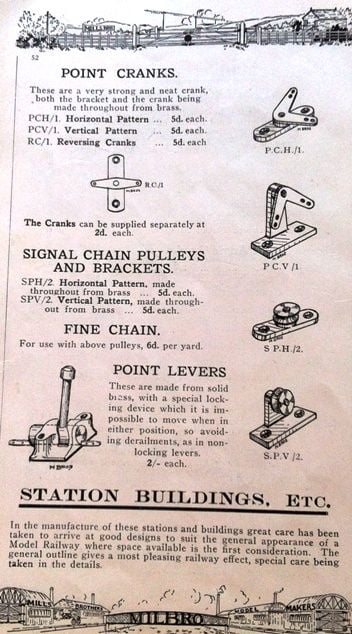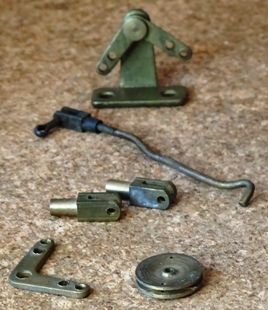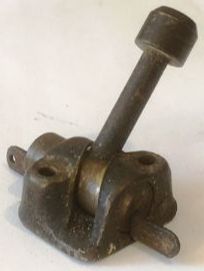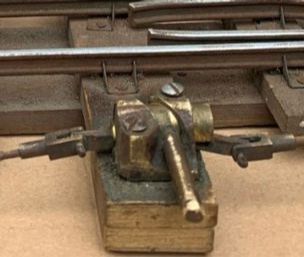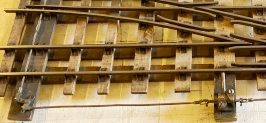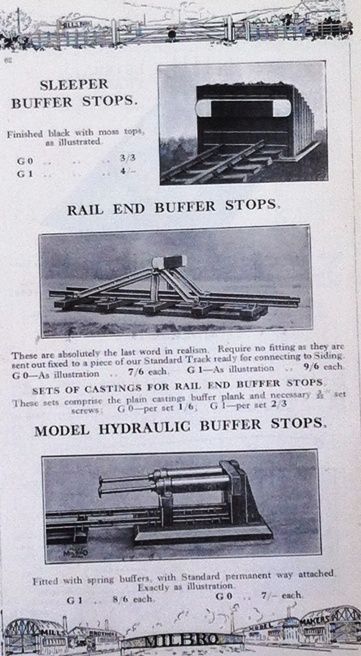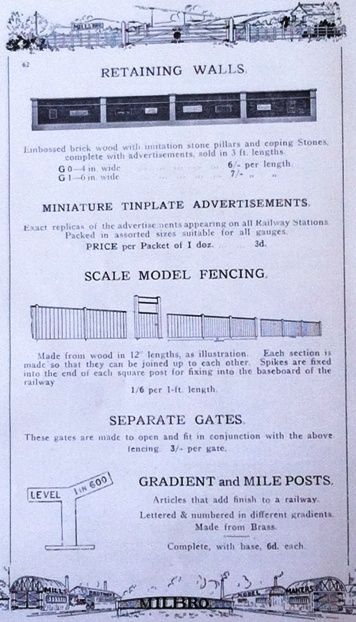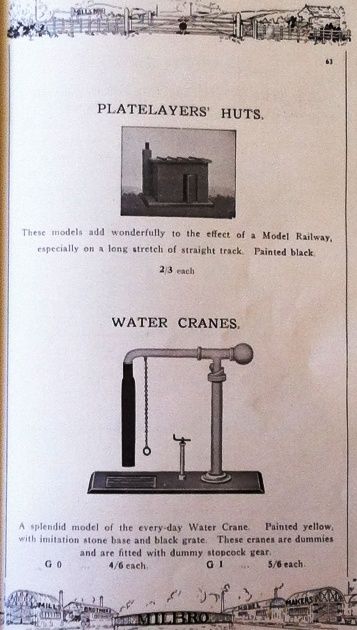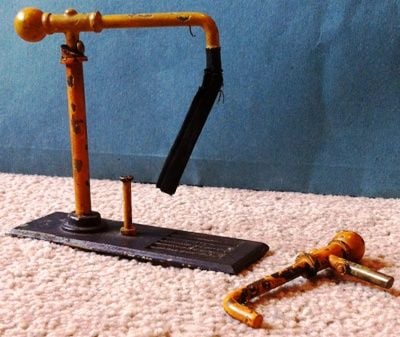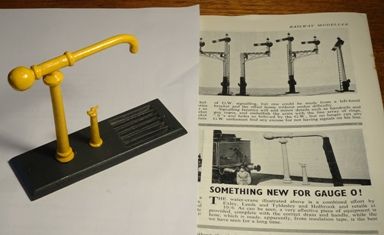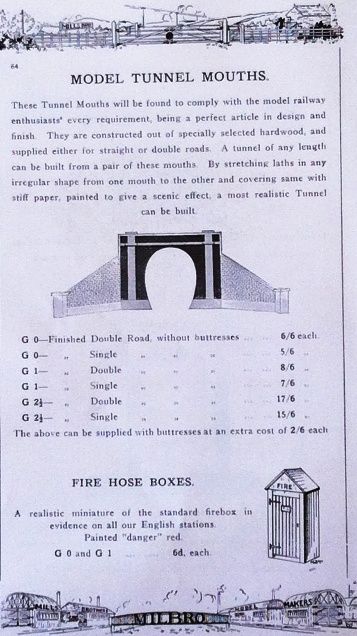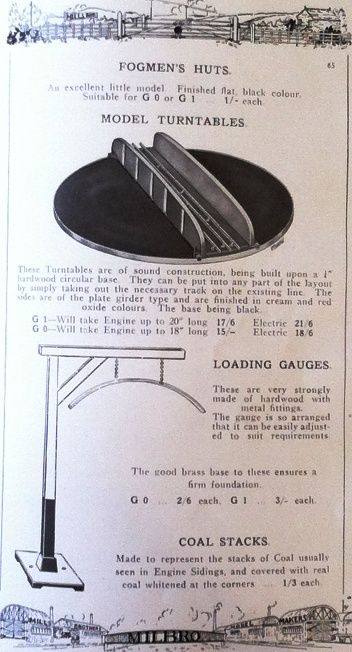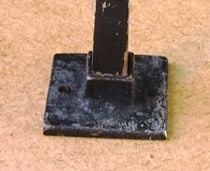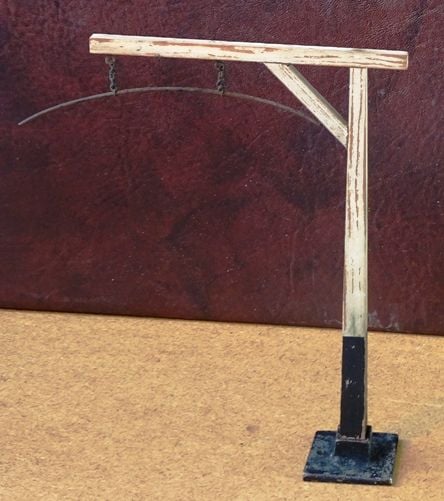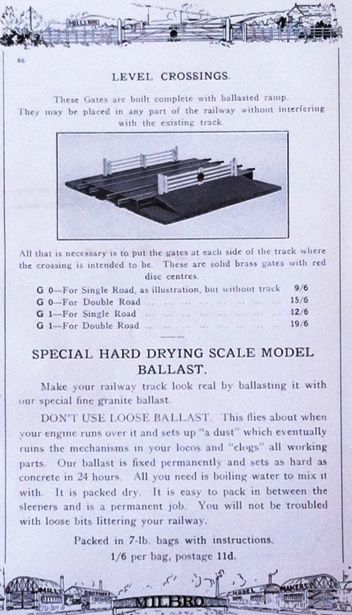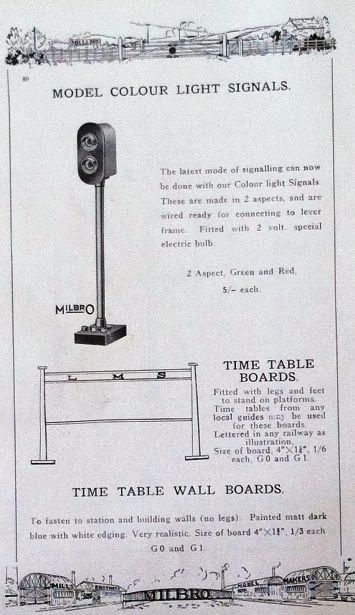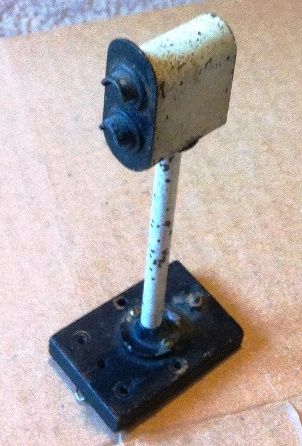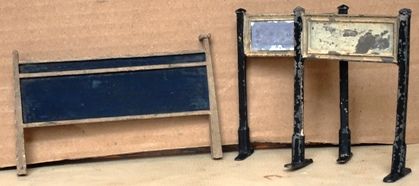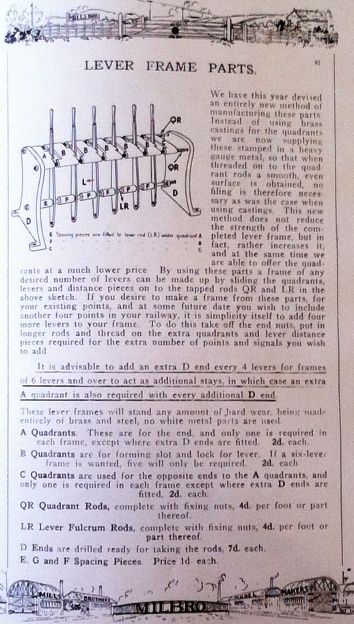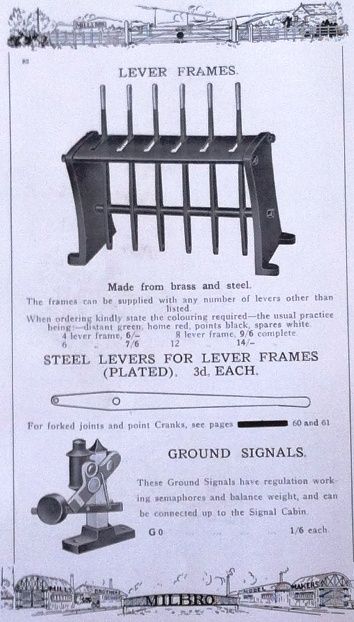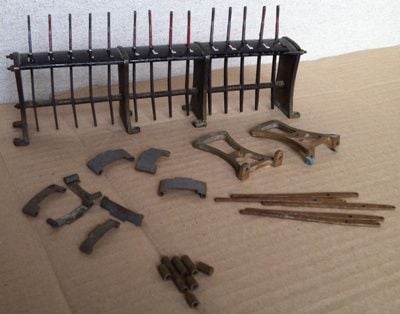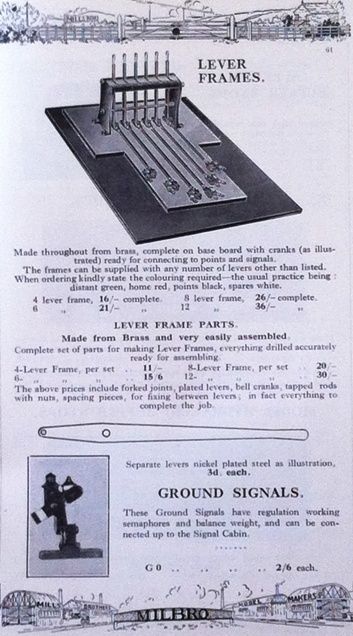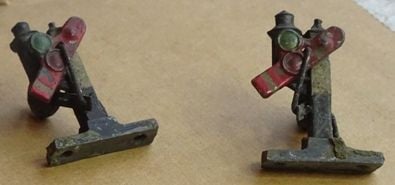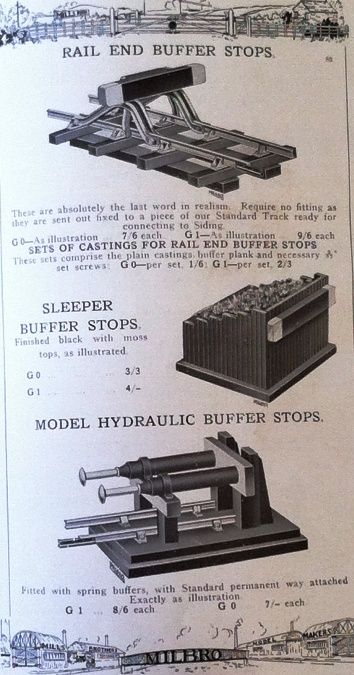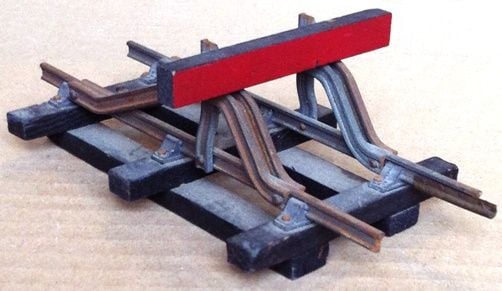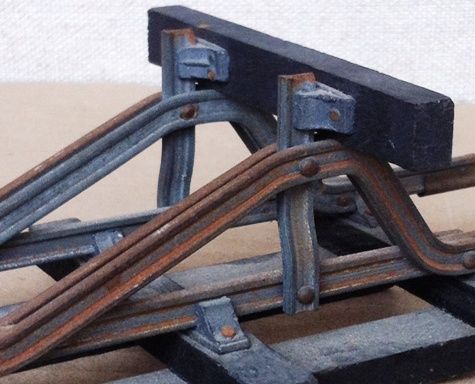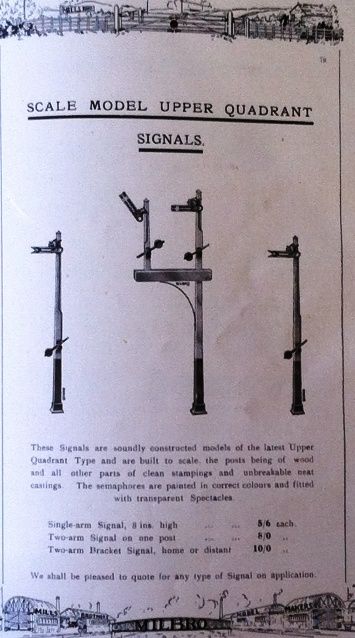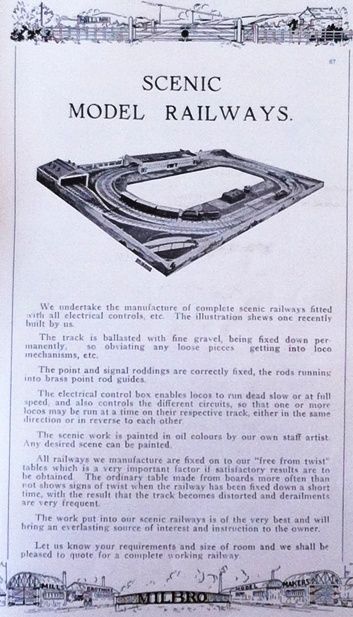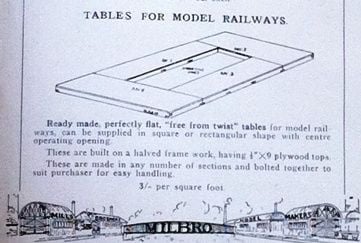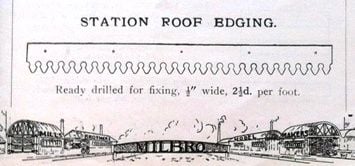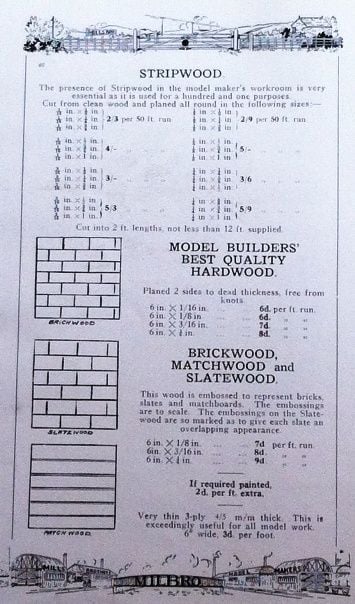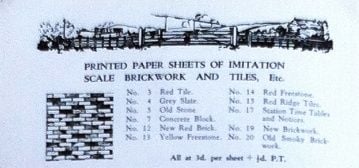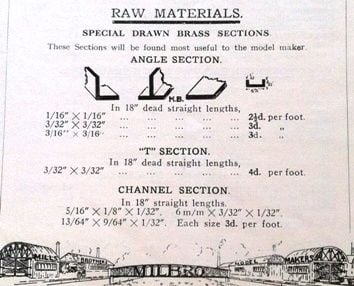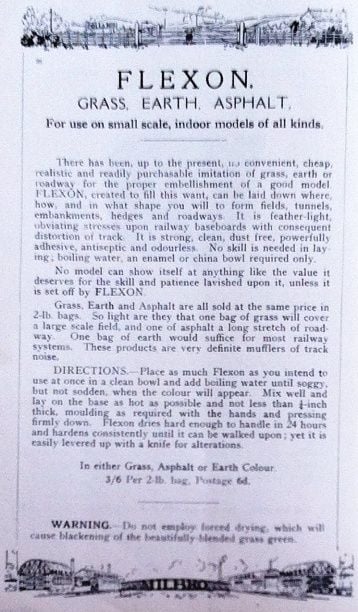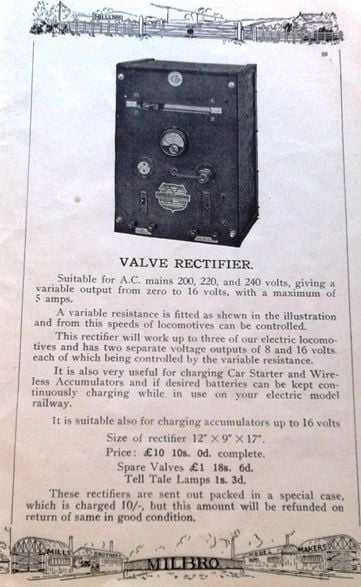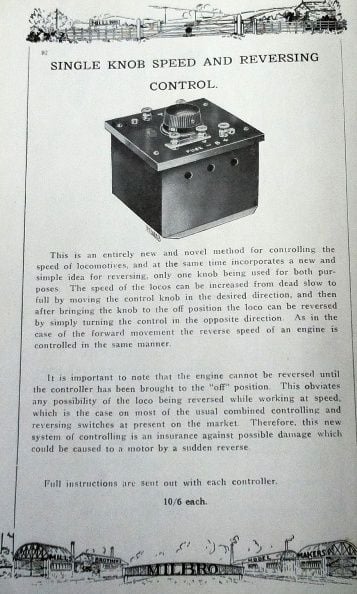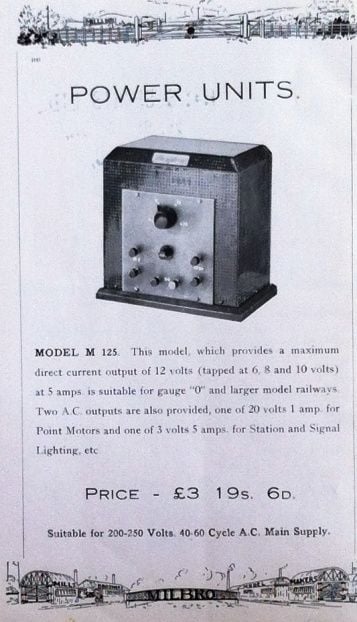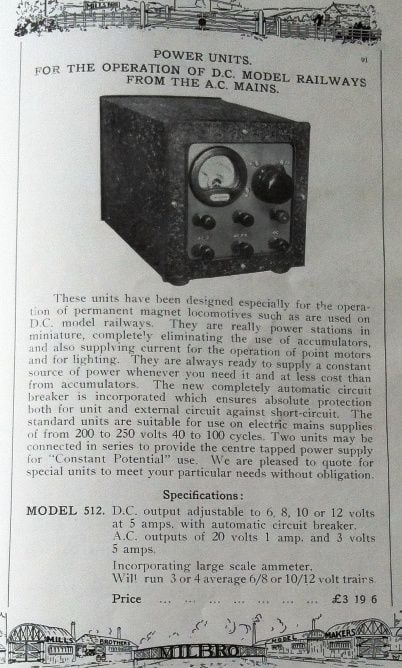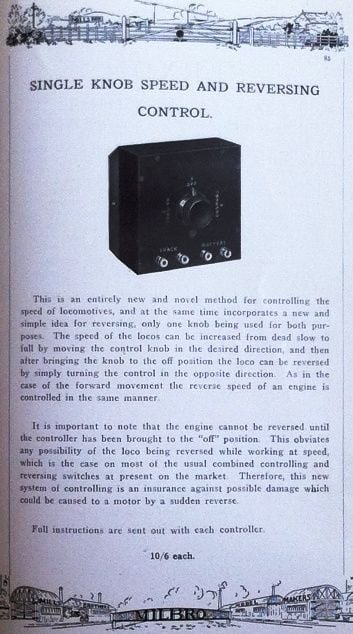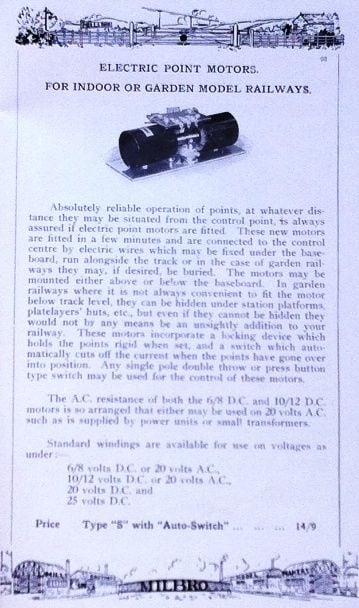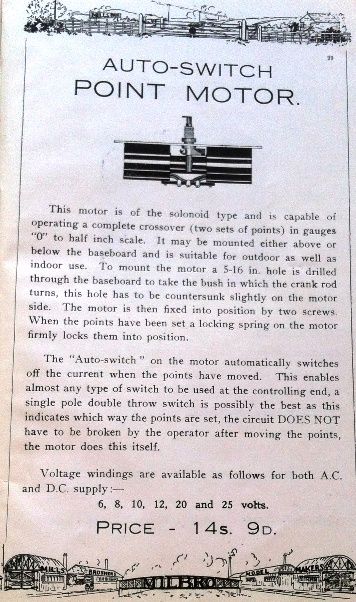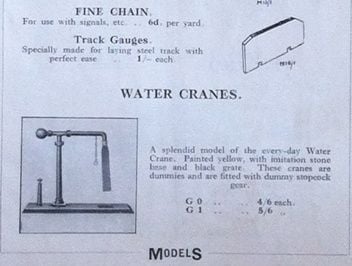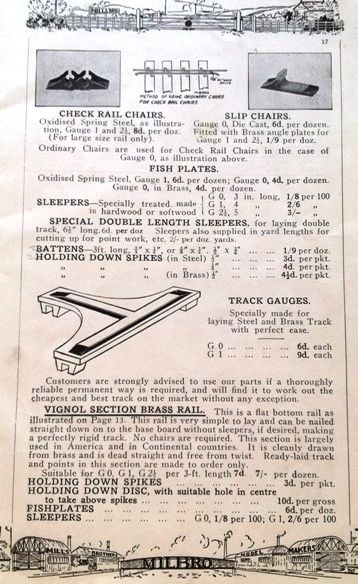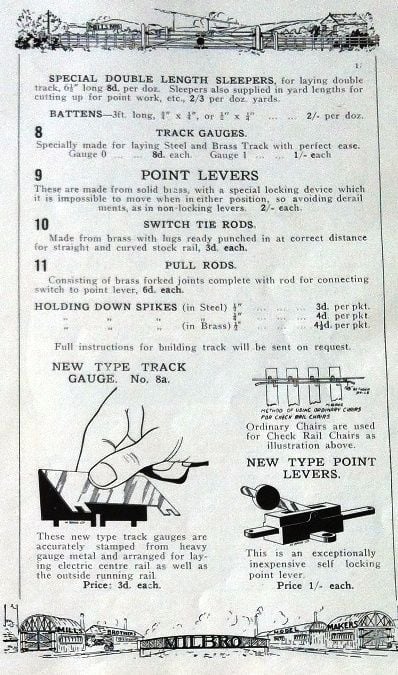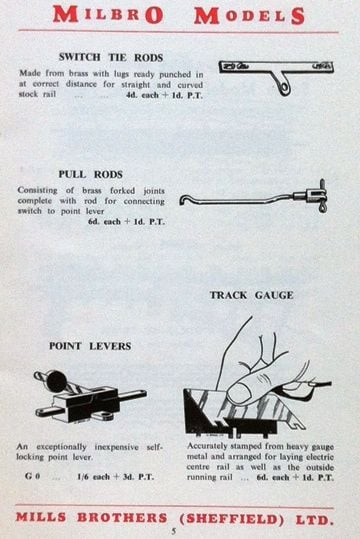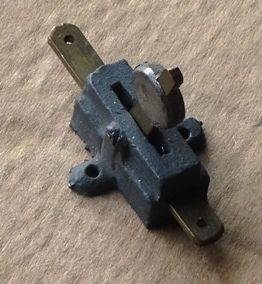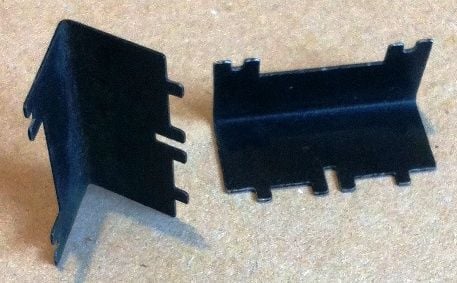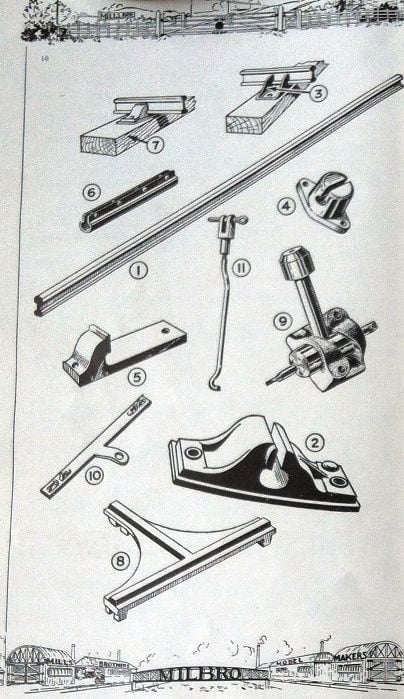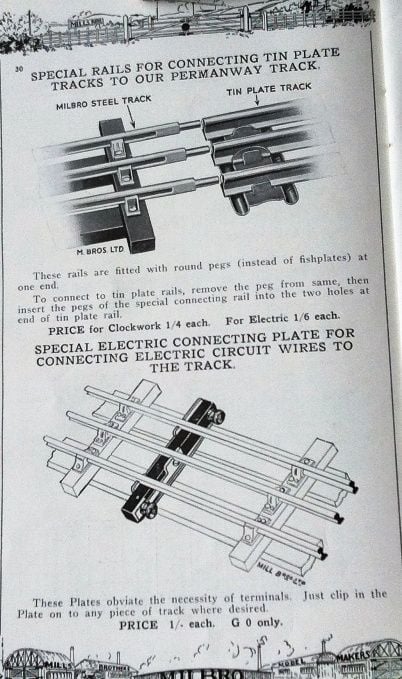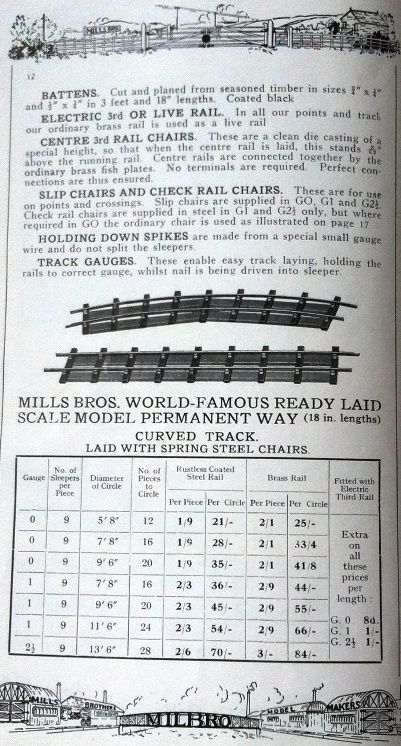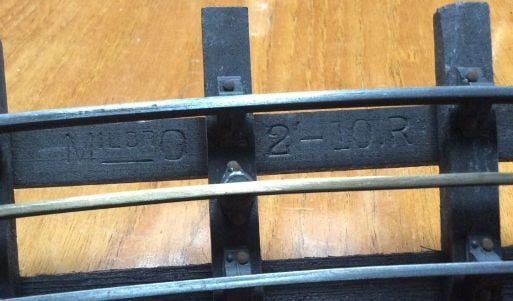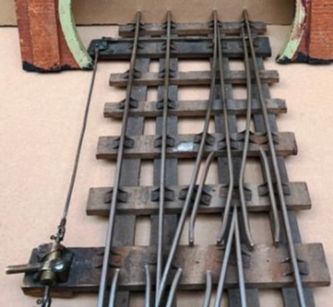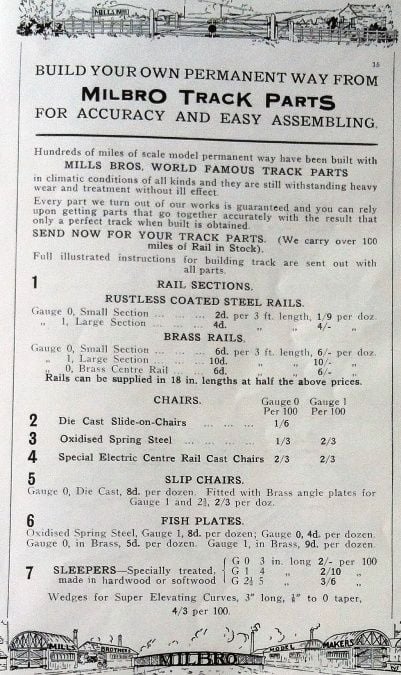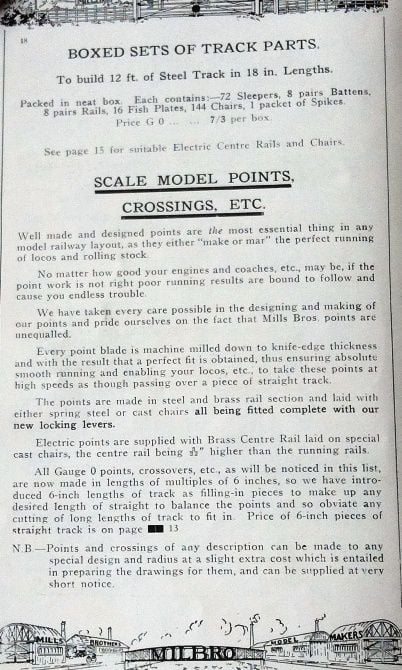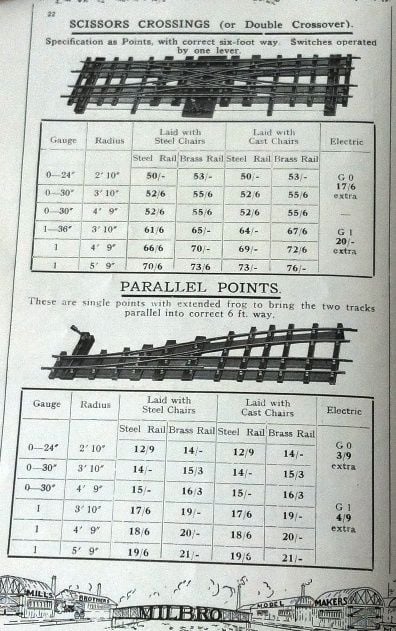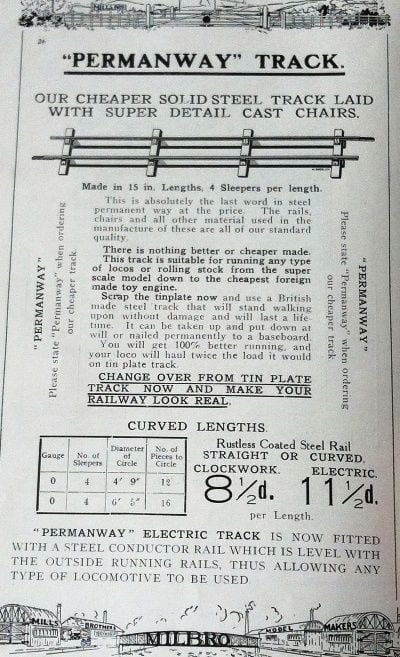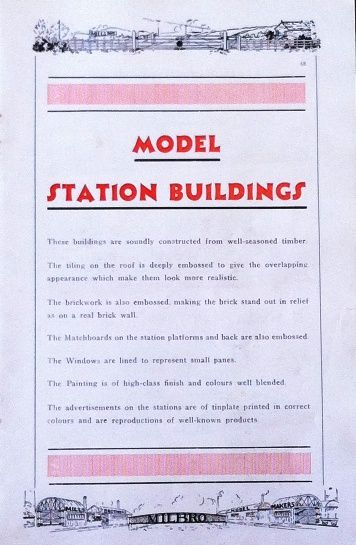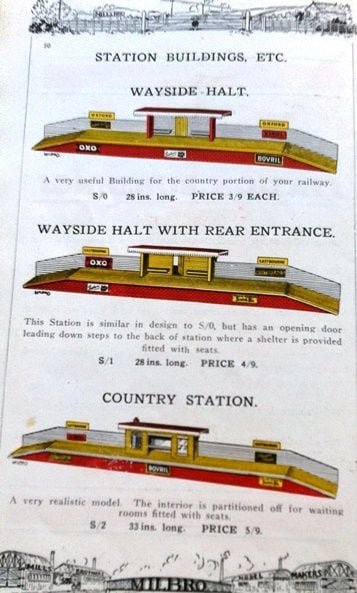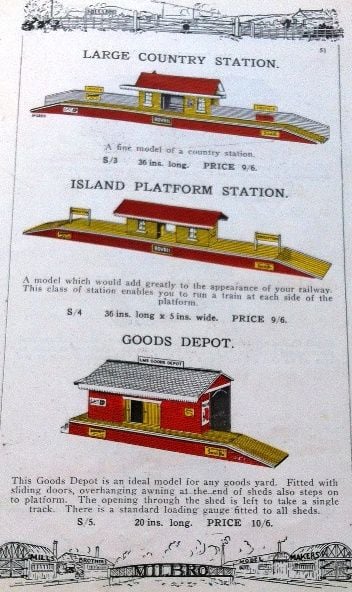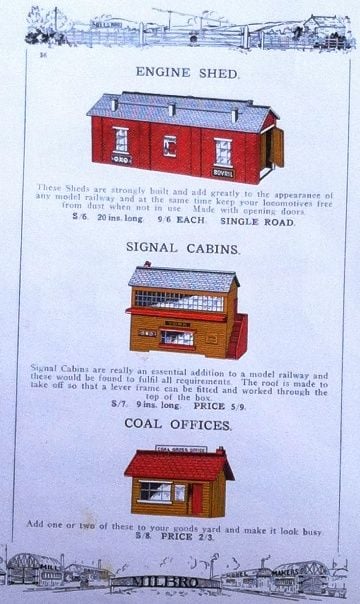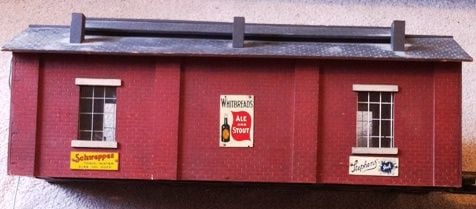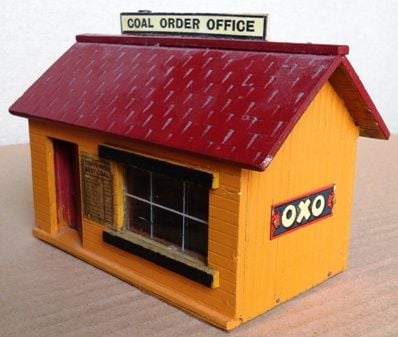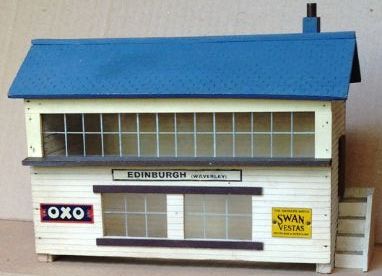
Other Milbro items* This section most recently updated in March 2023*
Other items catalogued by Milbro
Copyright is retained by M.L.Harrison for all text and photos, except for those taken by other owners and enthusiasts.
M.L.Harrison 2020 © All rights reserved.
The firm's catalogues show quite a wide array of buildings, accessories, and items to go with track. The coverage shifted a little over time, some items disappearing and others being added. The earlier buildings were eventually replaced by a simple later range, some of which seem to appear fairly often in auctions, on Ebay, and on traders' tables. I do not know how much of what was offered by Milbro was produced by them, as against being supplied to them from other firms and then sold by Mills to enthusiasts. Anything to do with or incorporating track seems likely to have been produced within their own factory, so the buffer stops (for example) would almost certainly have been a product of their own. Illustration O1. Milbro wooden buffer stops. These are sprung buffers comparable with the tinplate ones offered by other manufacturers. The tubes are of metal, but the base, beams, etc. are of wood. Wooden buildings do seem to have been produced directly by Mills, and the firm also sold suitable wood for other people to use from quite early on (and I have seen a very early advertisement referring to the firm supplying impressed/scribed wood). I cannot say for certain, however, whether the company also drew at all on other manufacturers in this product area before 1939, although I think there is some information about another firm supplying Mills with buildings later on (I hope to add more comment on this when time permits). As far as I can tell, many Milbro buildings from the series sold during the later 1930s do not carry the company name. The one shown below is an exception. The pictures of this goods shed illustrate the construction style and materials used for Milbro buildings from that era. Many enthusiasts for vintage trains probably will be familiar with the 'toylike' style.
Illustrations O2a, O2b and O2c. Examples of typical construction materials and features from a later period Milbro wooden building (a standard goods shed as catalogued), together with the trade mark (enlarged, from underneath). This is the only example I have of that trade mark, as such models often seem to come unmarked, and I only have a small group of buildings (given that storing them takes a lot of space!). I do not have a very substantial collection of Milbro accessories and lineside items upon which to draw for this section of the website, as I have never set out directly to hunt for the accessories or buildings. I will show some examples I have from the Milbro range, however, within the sub-section containing catalogue pages below. Although I have seen quite a few of the buildings, nearly all were from the later period, during which the company advertised them in a distinctive coloured section of their catalogue. Another enthusiast, however, has provided two earlier examples. Non-catalogued buildings in the same style also appear from time to time, although it may be hard to attribute them with complete certainty to Mills; I have seen two large carriage sheds and a handsome footbridge. There could be others.
Extracts from Milbro catalogues (with a few examples of the actual items sold) (i) Early wooden railway buildings, etc.
Illustrations O3a, O3b and O3c. Three catalogue extracts from fairly early catalogues. There is a reference here to North Light sheds, but no picture of one. The company offered buildings in several scales, including Gauge two-and-a-half. Track was already built into the loco shed, and its doors were apparently hinged.
Illustration O4. The water crane shown at this time differs from the one shown in later catalogues.
(An early Milbro Coal Office. This has lost the sign-board from its roof, and the material that formed the window pane, but should prove relatively easy to restore.)
Illustrations O5a - O5d. The catalogue extracts above include the earlier Milbro type of coal office and an interesting signal box. Along with these extracts we include two photographs of buildings like those in the catalogue pictures. I am grateful to the enthusiast who has provided these images. The two models seem almost certain to be by Milbro, and from the period before the production of the later series of buildings referred to below. Early Mills versions like these two seem very rare.
(ii) Turntables, loading gauges, level crossings, signals, signal rods, people, buffers, lever frames, fences, etc.
(This model is not quite the same as that in the catalogue page above, but almost certainly made by Milbro. It looks like a transition version between the two catalogued types. There is some damage at the right hand end. The description in the catalogue above does not match the catalogue picture, as the text refers to a full circular wooden base. The next photo below shows a Milbro turntable of that type, probably from this catalogue period. A later version with this circular type of base can be seen further down our set of catalogue extracts. This grey one is probably a rare example, having survived more-or-less intact after removal from its layout. I think it probably came from a particular model railway initially built and operated for a school.)
(The larger level crossing here is believed to be the Mills catalogued version, while the single track crossing is thought likely to be a smaller design by the same supplier. Many thanks for these photos to the two owners of these rare accessories. The crossings are well-made, using brass, and the split pins that were so often used by Mills have been deployed in the creation of the larger one .)
(Parts like these must have been used quite widely when enthusiasts built their 0 gauge model railways, as they seem to turn up frequently [and of course many are still in use]. I do not know whether these examples were made by Mills or one of the other manufacturers, but some at least seem to be in Milbro style, and they are all of brass.)
(This seems to be an example of the Mills point lever, which is made of solid brass. As far as I can tell, it is much less common than the Basset-Lowke ones.)
(A lever in use on a layout. Thanks to the enthusiast who sent me these two pictures and another below that shows trackwork with the type of chairs seen here.)
(Water cranes with similar features were sold by Milbro and Bassett-Lowke. This one more or less conforms to the later of the Mills designs, rather than being like the one shown earlier in Illustration 04. It lacks its chain and the handle from the top of its shorter vertical column. I have also shown the top section from another one to indicate how the crane was assembled; the top part can be turned.)
(In the early 1950s Exley could still supply a 'swivelling' water crane which was most likely the Mills version, but Exley later seems to have collaborated with Leeds and T&H to generate a successor. Perhaps Leeds or Exley made the item, or it was the work of a subcontractor. The one shown now seems to be an example, and does not 'swivel'! It seems to be made all or in part from aluminium. In my photo it is standing with a copy of the Railway Modeller of 1958, which featured the new water crane; see 9, April, page 94.)
(Believed to be an example of the Milbro type of loading gauge. The base is of brass, as catalogued, and has two neat holes in it. I cannot say whether it once had 'feet' at its corners (as in the catalogue picture), but it is conceivable that that an enthusiast filed them off long ago in order to make it look less toylike on a layout. Thanks to Cyril Kennett for identifying this uncommon item and bringing it my attention.)
(This seems to be a Milbro colour light signal. It has a wooden base, and is probably rather rare.)
(Two kinds of platform accessories: wooden for displaying notices, posters and timetables; and [early] metal for station names, etc. I need to replace the feet and one of the pieces of wood from the top of the timetable board)
(Made up lever frames, with some separate parts shown in front.)
(These look as if they are examples of the Milbro ground signal, although I cannot be sure. They are quite good models and match the illustrations well, but are made of soft metal components rather than including wood and brass. If they are the standard Milbro versions, then probably Mills bought in the parts from another maker or sub-contractor. Other soft metal ones of differing designs can be found, but I understand that the Leeds ground signals are assembled using brass, etc., and the Bassett-Lowke ones are also of wood, tinplate, etc.)
(The two photos above show some of the features of a standard rail-built buffer stop.) Illustrations O6a-O6ziii. These extracts show something of the variety being offered in the 1930s. There is a little overlap with our sub-section (below) focussed on track and related parts.
(iii) Complete layouts, scenic and building materials, etc. (NB Items for building locomotives and rolling stock are dealt with in other sections of this site)
Illustrations O7a-O7g. The company not only provided specific materials for modellers, but could also produce substantial complete layouts to order.
(iv) Electrical equipment for running model railways (NB Loco motors and components for mechanisms are dealt with in the Locomotives section of this website)
Illustrations O8a-O8g. Some controllers or related items may seem out of date or even archaic today, but the catalogue entries might still provide interesting historical insights. I have only ever met one collector who specifically sought out controllers, and I do not have any relevant examples in my own collection to show here.
(v) Track gauges, components, track, etc. (selective examples)
Illustrations O9a and O9b. The track gauges included in these two extracts are relatively early types. The lower example is a form of gauge that may have been available from other retailers as well as Milbro, and Mills supplied it in gauge One as well as gauge 0.
(I assume that this type of lever would have been bought in from elsewhere.)
Illustrations O9c, O9d and O9e. The type of track gauge seen in these three pictures was available in the later pre-war years and also after the war.
(Many thanks to the enthusiast who sent me this photograph, which shows how the firm identified its track and might also give the radius on a specific item. I do not know whether this stamping of items was standard practice for all periods or types of track.) (Thanks also to the enthusiast who took this picture of trackwork that has been assembled using the type of 'spring steel chairs' offered by Mibro, and also by Bond's. The majority of vintage track that turns up today has the soft metal type of chairs.)
Illustrations O10a-O10i. Milbro offered a good variety of components and made-up track. It seems that their track products were well regarded, perhaps especially their 'scale model' range. The catalogues showed a wider array than is presented above.
(vi) Later period wooden buildings The most well-known Milbro buildings are those of the later series, including the engine shed, signal box, etc. Construction and design are very simple, but the items seem quite well liked by collectors. They probably had good 'play value' on layouts (and no doubt many still do).
Illustrations O11a-O11d. An introductory page referring to the buildings, together with pictures of the specific models.
Illustration O12a. Standard late period engine shed. Since this building was first sold to a customer the windows have been upgraded to glass and track has been inserted. It has also lost its opening double doors from the front. There is wiring at the rear which runs to a bulb mounted inside. I do not know whether there would originally have been metal fittings on the tops of the chimneys/vents, but so far I have not seen these on this type of loco shed.
Illustration O12b. This example of a coal order office has been renovated, and a base and advertising signs have been added. The door has been given hinges, rather than the simple pin arrangement it would have had when made.
Illustration O12c. A standard Mills signal box from the same period, in this case labelled for Edinburgh. Other names may be found. The roof can be lifted off, and fits fairly casually onto the walls. I bought this signal box from a West Country shop for antique toys in 1995. The model apparently had been used as part of a layout created for an episode of the television series about a fictional antiques dealer, 'Lovejoy'. I renovated the model. This included putting in new glass to replace damaged glass in the upper window, and also glass to replace the deteriorated perspex that had been in the lower window. |
